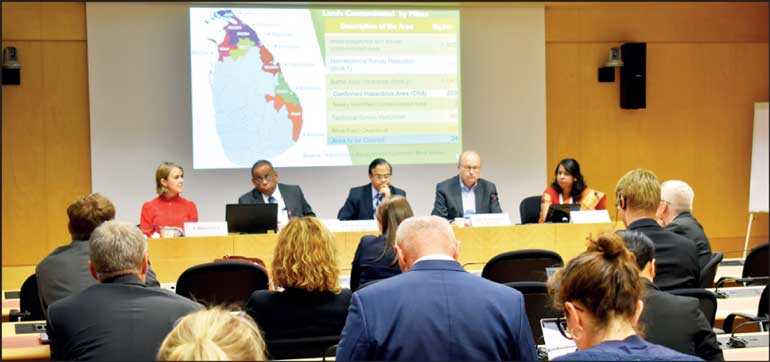Friday Mar 14, 2025
Friday Mar 14, 2025
Saturday, 1 June 2019 00:00 - - {{hitsCtrl.values.hits}}


The review meeting on mine action was held with the Main Forum and Side Event in Geneva from 22 to 24 May and it was reported that originally 1,302 square kilometres were suspected and confirmed hazardous areas with mines mainly in Northern and Eastern Districts of Sri Lanka.
The Government has given special attention to the demining program and as a result, as at April 2019, the balance uncleared contaminated area to be cleared is reduced to 25 square kilometres according to the Information Management System for Mine Action (IMSMA).
However, on the ground the remaining balance as at now is 18.5 square kilometres which is a commendable achievement when compared to many other countries said Ministry of National Policies, Economic Affairs, Resettlement and Rehabilitation, Northern Province Development and Youth Affairs Secretary V. Sivagnanasothy.
The National Mine Action Centre which comes under the direct purview of Ministry of National Policies, Economic Affairs, Resettlement and Rehabilitation, Northern Province Development and Youth Affairs is directed by the Prime Minister as Minister of the subject. At the previous meeting Prince Mired Raad Zeid Al-Hussein made a positive comment on the progress made by the Government of Sri Lanka on the demining program.
Sri Lanka is targeting to achieve the vision of mine free country in 2020. However, the funding from donors is an immediate requirement to clear the balance contaminated areas. The Government of Norway has committed to provide assistance to the value of $ 6.8 m recently. Other donors are also keen to support the demining programme and the total fund requirement is estimated to be $ 30 m.
Sri Lanka has been able to successfully reduce the injuries and deaths significantly through an effective Mine Risk Education Program for which UNICEF and other development partners closely collaborated. The Mine Risk Education Program covered the school children, teachers, community and also the vulnerable groups specially the metal scrap collectors and firewood collectors. Also the safe play areas were identified for children and thereby reduced the number of deaths and victims significantly as compared to other countries. This message was considered as success story by many partner countries which participated in the Geneva Forum.
Victim assistance is an area where globally not much attention has been given in the past and an area which has been under-funded. Sri Lankan National Mine Action Strategy has given much emphasis to victim assistance such as first aid, medical care, counselling, psycho-socio support, prosthetic (artificial limbs) and assisting devices such as wheel chair, clutches, walking sticks, etc.
The focus of the Mine Action Strategy is to provide vocational and technical training and redeploy the mine victims to enable them to socially and economically reintegrate into the society. The strategy also provide avenue to harness private sector funds under cooperate social responsibility said Sivagnanasothy.
HELO Trust, MAG, DASH, SHARP and Sri Lankan Army are involved in the mine clearance operations. The Sri Lankan Mine Action Program is considered as successful in view of high-level commitment by Government, national ownership, coordination and monitoring in the Government and partnering with donors, INGOs. NGOs including UN agencies and Implementation Support Unit of the Geneva International Centre for Humanitarian De-Mining (ISU-GICHD),
Sri Lanka submitted its Progress Report in line with the article 5 of Ottawa Mine Ban convention. Sri Lanka destroyed 737,464 Anti-Personnel Mine 1,407,689 other explosives in line with the convention. Also, Sri Lanka complies with the National Mine Action standards and prioritize high impact areas such as residential areas for resettlement, livelihood areas, and areas that need access to school, hospital and religious places including development of agriculture and infrastructure areas.
The implementation Support Unit (ISU) and Geneva International Centre for Humanitarian Demining (GICHD) very closely collaborate with the Ministry of National Policies, Economic Affairs, Resettlement and Rehabilitation, Northern Province Development and Youth Affairs to facilitate fund mobilisation for the implementation of the Mine Action Program. The progress made by Sri Lanka on Mine Action Program was commended by Ambassador Hans Brattskar, Permanent Representative of Norway to the UNO in Geneva and Asa Massleberg, Advisor, Strategic Management, Geneva International Centre for Humanitarian Demining and other partner countries.
The review meeting was attended by Ambassador Stefano Toscano, Director of the Geneva International Centre for Humanitarian Deming, the Ambassador Hans Brattskar, Permanent Representative of Norway to the UNO in Geneva, Sivagnanasothy, Ambassador A.L.A. Azeez, Permanent Representative of Sri Lanka to United Nations Organization in Geneva, Juan Carlos Ruan, Director, Implementation Support Unit of GICHD, and Asa Massleberg, Advisor, Strategic Management, Geneva International Centre for Humanitarian Demining (GICHD) and many other officials from various partner countries.
Discover Kapruka, the leading online shopping platform in Sri Lanka, where you can conveniently send Gifts and Flowers to your loved ones for any event including Valentine ’s Day. Explore a wide range of popular Shopping Categories on Kapruka, including Toys, Groceries, Electronics, Birthday Cakes, Fruits, Chocolates, Flower Bouquets, Clothing, Watches, Lingerie, Gift Sets and Jewellery. Also if you’re interested in selling with Kapruka, Partner Central by Kapruka is the best solution to start with. Moreover, through Kapruka Global Shop, you can also enjoy the convenience of purchasing products from renowned platforms like Amazon and eBay and have them delivered to Sri Lanka.
Discover Kapruka, the leading online shopping platform in Sri Lanka, where you can conveniently send Gifts and Flowers to your loved ones for any event including Valentine ’s Day. Explore a wide range of popular Shopping Categories on Kapruka, including Toys, Groceries, Electronics, Birthday Cakes, Fruits, Chocolates, Flower Bouquets, Clothing, Watches, Lingerie, Gift Sets and Jewellery. Also if you’re interested in selling with Kapruka, Partner Central by Kapruka is the best solution to start with. Moreover, through Kapruka Global Shop, you can also enjoy the convenience of purchasing products from renowned platforms like Amazon and eBay and have them delivered to Sri Lanka.